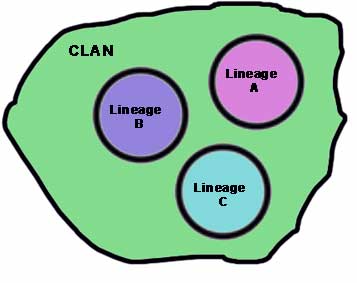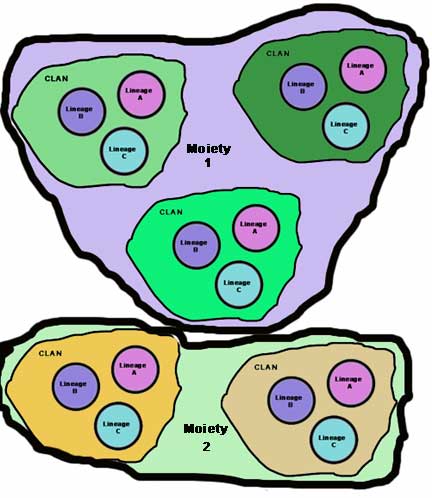Clans and Other Large Unilineal Descent Groups
A lineage is usually the smallest group with corporate functions in a culture with unilineal descent. Members of a lineage can trace their relationship through males (in a patrilineal system) or through females (in a matrilineal system) back to a common male or female ancestor. Most cultures are only able to do this back perhaps four or five generations. If they believe they are related, but can not actually trace their relationship, then the resulting groups are called clans. Normally, several lineages would be in a clan, as depicted graphically below.

A Clan
Clans are therefore unilineal descent groups. Since the United States does not have unilineal descent, we do not have clans. Clans can be either patriclans, in cultures with patrilineal descent, or matriclans, in cultures with matrilineal descent. In the Yanomamo, lineages are the largest kin group; in both the Nuer and the traditional Hmong, it is the clan.
Clans, like lineages, are exogamous, and in a patrilineal system, everyone takes their clan from their father. Clan members do consider themselves to be related, even though they can not precisely trace how. Clans are often named (as in the Hmong) and sometimes the common clan ancestor is partly mythical and/or supernatural. Clans may have corporate functions in some cultures, including settling disputes, owning property, and organizing the clan to support its members.
Moieties and Phratries
In some cultures with unilineal descent there are even larger kin groups. In some cultures, the entire culture is divided in two large groups, each composed of two or more clans. These two large kin groups are called moieties.

Moieties
Moieties like clans are exogamous, and in a patrilineal system Ego would take his moiety from his father. Since moieties are exogamous, and there are only two such groups in the culture, everyone in moiety 1 must take their spouse from moiety 2, and vice versa. In this way, everyone in the culture is either close kin (in your moiety) or a potential spouse or in-law. The moiety system (not found in any of the cultures we are looking at) is thus an ingenious way to encourage appropriate social behavior between individuals, and thus maintain social control. (Incidentally, Ego's cross cousins would not only be outside his lineage, but also his clan and his moiety! Hence they are always available for marriage.)
Phratries are also large groups based upon unilineal descent, each consisting of two or more clans. With phratries however, there are more than two such large groups in the culture, which is the difference between phratries and moieties.
|